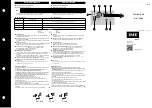
I.L. 41-503N
voltage to approximately 15 volts ac and the
T unit should drop out. At rated voltage the
time delay obtained should be 6 cycles. The
timer can be set to provide up to 30 cycles
delay by adjusting the rheostat located on
the rear sub base. (See Figure 1). Time vs
voltage curves are shown in Figure 9.
3. DC Operation
Energize terminals 10 and 4 with rated dc
voltage. Place switch across KF relay con-
tacts. Closing the switch will now energize
the timing circuit. The time delay obtained
from the telephone relay should be 6 cycles.
The timer can be set to provide up to 30
cycles delay by adjusting the rheostat
located on the rear sub base. See Fig. 1.
Routine Maintenance
All relays should be inspected and checked
periodically to assure proper operation. Generally
a visual inspection should call attention to any
noticable changes. A minimum suggested check on
the relay system is to close the contacts manually
to assure that the breaker trips and the target
drops. Then release the contacts and observe that
the reset is smooth and positive.
All contacts should be periodically cleaned. A
contact burnisher S#l82A836HO 1 is recommend-
ed for this purpose. The use of abrasive material
for cleaning contacts is not recommended, because
of the danger of embedding small particles in the
face of the soft silver and thus impairing the con-
tact.
Calibration
Use the following procedure for calibrating the
relay if the relay has been taken apart for repairs
or the adjustments have been disturbed. This
procedure should not be used unless it is apparent
that the relay is not in proper working order. (See
“Acceptance Check”).
A. Induction Cylinder Unit
1. The upper pin bearing should be screwed
down until there is approximately 0.025”
clearance between it and the top of shaft
bearing. The upper pin bearing should then
be securely locked in position with the lock
nut. The lower bearing position is fixed and
cannot be adjusted.
2.
0
3.
The contact gap adjustment for the cylinder
unit is made as follows:
With the moving contact in the normally-
opened position, that is, against the right
stop on the bridge, screw in the right hand
stationary contacts until it just makes with
the moving contact. Then advance the
stationary contact an additional ‘/4 turn.
Screw the left hand stationary contact until
it just touches the moving contact then back
off the stationary contact two turns for a
gap of l/ 16 of an inch. The clamp holding
the stationary contact need not be loosened
for this adjustment, since the clamp utilizes
a s p r i n g - t y p e a c t i o n i n h o l d i n g t h e
stationary contact in position.
The set screw in the stationary contacts has
been shop adjusted for optimum follow and
this adjustment should not be disturbed.
The moving contact assembly has been fac-
tory adjusted for low contact bounce perfor-
mance and should not be changed.
The sensitivity adjustment is made by vary-
ing the tension of the spiral spring attached
to the moving element assembly. The spring
is adjusted by placing a screwdriver or
similar tool into one of the notches located
on the periphery of the spring adjuster and
rotating it. The spring adjuster is located n
the underside of the bridge and is held in
place by a spring type clamp that does not
have to be loosened prior to making the
necessary adjustments.
The spring is to be adjusted such that when
the relay is deenergized the moving contact
just resets. Then move the spring adjuster
3/16 of a turn in the same direction.
B. Frequency Adjusting Reactor
The relay should be preheated for 1 hour with
120 volts and rated frequency before calibra-
tion is attempted. A source of variable frequen-
cy is required and should be connected to ter-
minals 8 and 9 of the relay.
Set the source frequency to 59.5 hertz and ad-
just the frequency adjusting screws (see Fig. 1)
until the cylinder unit contact closes to the left.
7






























